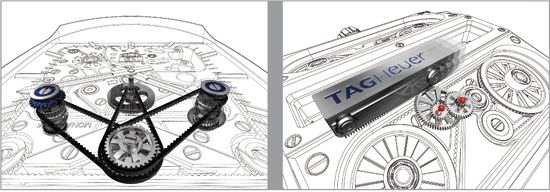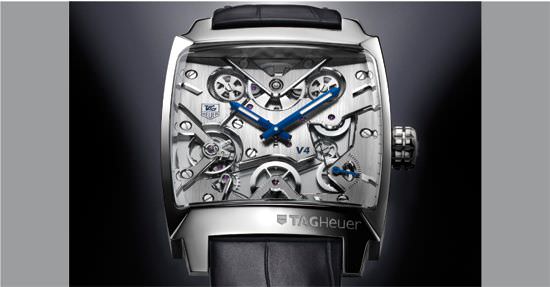TAG Heuer is approaching its 150th anniversary (2010) and perhaps the most important project in all those years is the V4 Concept Watch.
Why?
The V4 has set TAG Heuer on a direction that vali-dates the company’s past while at the same time insuring its future.
“It is a crowning piece of our 150 years of know how and expertise,” says Jean-Christophe Babin, President and CEO, TAG Heuer. “It’s a true reinvention of watchmaking, really expressing avant-garde and providing us a timepiece as exceptional as a tourbillon. The V4 gives us a unique and extremely innovative mechanical complication - it will be the flagship rather than the bloodstream of the brand.”
The beginning
The V4 started out, in 2003, as a crazy concept that no one was sure would ever work.
“At that time, we were less innovative than we were in the 1960s and 1970s, and for us it was about how we could get back to where we were in terms of innovation,” recalls Stéphane Linder, Product Director, TAG Heuer. “We wanted to do something incredible with a movement - we saw all the fashion brands doing tourbillons and other complications, and we knew that TAG Heuer coming with one more tourbillon didn’t make sense and wouldn’t get noticed. Our thinking behind the V4 was to make something innovative but also true to our TAG Heuer DNA – motor racing, avant-gardness and design. We said that we needed to make something totally different and, if possible, a real breakthrough, something that reinvented the basic principles of watchmaking.”
TAG Heuer was already working with watchmaker Jean-François Ruchonnet on some other projects and, inspired by the engine in his car, Ruchonnet proposed the idea of using belts instead of the traditional gears in a watch, watchmaker Philippe Dufour was brought in to work with Ruchonnet and TAG Heuer to develop the concept further. “We asked, what could it bring to the world of watchmaking?” Linder said. “We decided that it could have a chance. Together, the design team came up with the V4 with the belts, the four barrels and the sliding weight. We knew we had something really different, something that could stand on its own and be instantly recognized. We didn’t know if it would work, we didn’t know how it would do in performance, so we decided to make a concept watch from it.”
TAG Heuer introduced the V4 Concept Watch in 2004 to an interesting mixture of responses. Some people took the watch for what it was, an attempt to do something new and previously untried. Others dismissed it as a marketing gimmick, a watch that would never, ever work. Still others took a wait and see attitude – reserving judgement until the watch actually worked.
“First, if we would have been Patek, people would have accepted our efforts, but since we are TAG Heuer, they doubted that it would work,” Linder says. “They thought it was just a marketing thing. We like to challenge the establishment, that’s for sure, but so many watchmakers thought we were completely crazy, they didn’t think it would work. They thought the friction of the belt itself would prevent the mechanism from working.
“At that first Basel in 2004, we were so proud to present the product that people thought we were arrogant, but that was not the case, we were just really excited,” Linder adds. “After that, we invited journalists to come to our factory – we said that we didn’t know if it would work, but we were trying. Every year, we have explained where we are in the development. We have really been working hard to make something different.”


Trial and error
After the concept watch’s introduction, TAG Heuer continued to work on the V4, disregarding the doubters, outside and inside the company. Luckily, the project had the support of key people high up at TAG Heuer, so despite the money spent on a watch that didn’t function, yet, Linder kept working, testing, building prototypes, researching materials and more.
“Except for the balance wheel, we had to redo everything else in the watch,” Linder details. “It was a lot of back and forth, a lot of testing. We introduced it, gauged the interest, then hired a team of engineers, designers, watchmakers, and then it was years of up and down, finding solutions and then realizing other problems. We had to reinvent the wheel in every situation and if one part didn’t work, we didn’t know what the reason was. It was really difficult, with a lot of pressure, because this project was extremely expensive and no one knew if it would work. We also never knew if the project would get stopped at any time, because it was so expensive.
“I was pushing hard for this project, but because it cost so much money, I had to keep convincing everyone to do it,” he continues. “After we introduced the Concept Watch, the reaction of people was what kept the project going. If we had done the project internally, without talking about it, we probably would have stopped it after a year or two. Because of all the press we got, all the people in TAG Heuer became sure that the gamble was worth it.”
At BaselWorld 2005, a year after the Concept was introduced, TAG Heuer showed that the belts were functioning, proving that the belts could turn and drive the balance wheel. An important step, of course, but no working watch yet.
At BaselWorld 2007, to the surprise of most of the watch industry, TAG Heuer unveiled a working prototype that had been tested and passed, confirming that toothed belts could be used instead of wheels and pinions.
The V4 was working.
At BaselWorld 2008, final prototypes, with the optimized linear winding system, were unveiled.

The V4 Basics
The V4 is a new watchmaking concept, taking its inspiration from engine functions. Instead of gear trains, the V4 uses belts and in place of a standard oscillating rotor, the V4 employs a linear weight. Revolutionary, certainly. Possible? Many people had serious doubts and weren’t shy about voicing them.
The limited series
After more testing and extensive additional research, at BaselWorld 2009, TAG Heuer announced that it would release the V4 in a limited edition of 150 watches.
“We now have the pre-series watches, working, on our wrists, so everything has been tested and it is ready to go,” Linder says. “Next year, we celebrate 150 years and we will have a limited edition of 150 pieces. The V4 has passed all the tests – precision, shock, water, winding, and now we just have to confirm the longevity of the watch. It is in that testing now.
“It is five years now, which is a long time, but that’s about what it takes to design a new movement,” acknowledges Linder. “But, if you go out to design a new chronograph, you know that it will eventually be done and work. With the V4, we never knew if it would ever be done and ever work.”
For TAG Heuer, the release of the V4 is redemption and confirmation that they are true inno-vators, not just the marketing behemoth that everyone accused them of being.
“I don’t like to be proud, but I am very proud of the V4,” says Babin. “Initially, very few people believed in it externally. Internally, we were convinced that it could work. I am very happy to show the world it’s not a marketing gimmick, but that it’s as serious as Breguet when he introduced the tourbillon. We succeeded in the face of a lot of sceptical and critical people. Secondly, we have been accused and mocked to be mostly a marketing company, the V4 coming right after the Calibre S, the Calibre 360 and the Monaco 69, shows that we are capable of pushing movements to new limits, to reinvent mechanics and to combine mechanics with quartz. The V4 shows to the world that TAG is not only a great marketing company, but it is also one of the most innovative Swiss technology companies when it comes to movements.
“We are going to start with 150 pieces of the V4, and after that the volume will be extremely limited,” Babin continues. “It is entirely manufactured, except the belts and the ball bearings, in-house here at TAG. We cannot do it in big volumes. The V4 will be a marginal piece because we don’t intend to manufacture thousands, we will only do a few.”
But TAG Heuer has proven that they CAN do it!
Source: Europa Star August-September 2009 Magazine Issue




